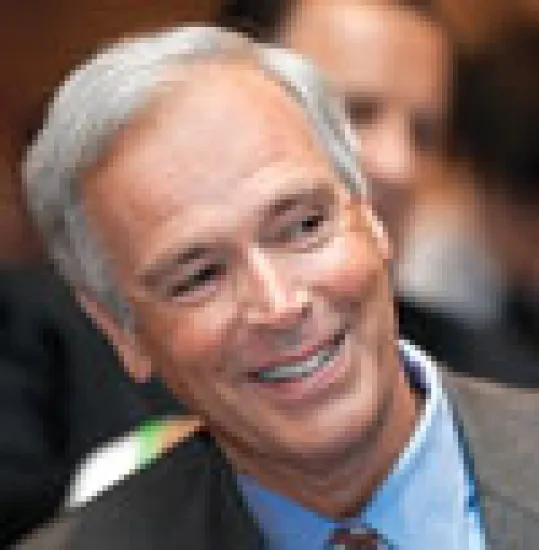When D. Scott Davis took the wheel as CEO of United Parcel Service in January 2008, no one knew that global commerce was about to go over a precipice. The company was moving about 15.5 million packages and documents a day, and Davis was busy figuring out how to accommodate brisk growth. By year-end the world was in deep recession, and Davis had to shift gears. He closed some facilities, cut about 10,000 jobs, froze management salaries and suspended the Atlanta-based company’s 401(k) match. Yet he also went on the offensive, bumping up UPS’s hybrid fleet to 2,200 vehicles, the most in the industry. He has continued to expand its hub and distribution centers, added 16 countries to UPS’s network of express pickup and delivery services and bought several small companies.
“There are some nice valuations to be had, our competitors are hamstrung by their balance sheets, and private equity isn’t as much of a factor,” Davis says. “This is no time to go into a cocoon.”
Unlike most companies, UPS typically taps a leader from among its senior execs, most of whom have been with UPS all their lives and at one time or another have handled packages. The 57-year-old Davis had been with the company for more than two decades when he was picked as CEO. But he was an outsider of sorts: Rather than working his way up internally, he joined UPS when it acquired the technology firm he was running, IIMorrow, in 1986. After holding several key positions, including the CFO job, Davis was promoted to vice chairman and then CEO.
Despite the recession, UPS remains the world’s largest package delivery company and has continued to ship goods that account for 6 percent of the U.S. economy and 2 percent of the global economy. But that has translated into fewer units as business has slowed. Second-quarter revenues were $10.83 billion, down almost 17 percent from the same period last year. Net income fell to $445 million, half of last year’s $873 million.
The stock price has not been immune, dropping 17 percent from Davis’s first day on the job through mid-September. Yet UPS’s shares lost less than did the S&P 500 index, which was down 27 percent, and have climbed 54 percent since the March 9 market low, just shy of the S&P 500’s rebound.
In a recent conversation with Institutional Investor Contributing Writer Claudia Deutsch, Davis explained why UPS is positioned to profit as the economy recovers.
Institutional Investor: Before the downturn your capital expenditures ran at 6 percent to 8 percent of revenue. This year they will be below 5 percent. How do you triage projects?
Davis: We’re pretty strategic about where we invest. It was very important to finish our international hub in Shanghai and to build an inter-Asia hub in Shenzhen, and to add two new wings to Worldport, our U.S. hub in Lexington, Kentucky. And we’re investing in companies that have useful technologies, like shipping software. But we’ve cut back at some regional hubs that do not handle international travel.
The recession is hurting your business. Yet for the most part, the stock hasn’t been hurt as badly as the S&P 500. Why the dichotomy?
We always outperform in a lousy market because we have a good balance sheet and a good competitive position, so we’re considered a safe-haven stock. Generating cash flow is a core strength of ours.
Did anything good come out of this recession for you?
Slower business meant we could retire older planes, so our air fleet’s carbon footprint is lower now than some of our competitors’ will be in 2020. And we’re going to keep modernizing.
DHL, one of our big competitors, pulled out of the U.S., and some of the trucking companies are in bad financial shape. Coming out of the recession, our competitive position will be the best ever.
Is the Obama administration doing enough to hasten the recovery?
I think the stimulus program will show benefits, because pouring money into the economy has to have some impact on the flow of goods. But I was disappointed with the Buy America program. Global trade is one of our best tools to get out of this recession. The deficit has improved, but only because imports have slowed. We should be leading by example — not giving cover to other countries that want to become protectionist.
My other hot button is infrastructure. I applaud the administration for what it plans to do with highways and bridges, but we need more done on rail, ports and air traffic control. When airplanes circle, they burn tremendous amounts of fuel and generate a huge carbon footprint. Trucks are eight times more efficient than planes, but rail is four times more efficient than trucks.
But air freight commands a higher price tag. Aren’t you shooting yourself in the foot?
Shipping by ground requires less invested capital, so you can generate good returns at lower margins. For international shipments, air still has the highest margins, but domestically we’re better off with more going by ground.
Before the downturn, UPS had been rolling out a sophisticated tracking technology that enables planes to fly closer together, thus reducing circling. Two years ago the Federal Aviation Administration was talking about replacing radar with your system. What happened?
The system has been formally proposed to Congress, but the question remains of how to pay for it. We’ve slowed our internal conversion until we see what happens.
Are your trucks and planes as ubiquitous overseas as they are in the U.S.?
We’ve been in Europe since the 1970s, so our business there is pretty much like it is here. And we have strong businesses within Mexico and Canada. But we’re not where we want to be in Asia. We’ve done well on China’s import–export business. As the Chinese middle class grows, the tremendous growth opportunity will be in moving packages within China.
Historically, UPS has confined itself to the pickup and delivery business. But these days you’re repairing laptops for Toshiba and handling distribution for many manufacturers. Why are you moving away from your roots?
Supply chain management isn’t capital intensive, and it helps us build a new customer base. We do freight forwarding, which is contracting with third parties like commercial cargo jets or ocean shippers to move heavier goods. We’re offering customs brokerage services. We’ve gotten into inventory management and logistics. So yes, supply chain management is a major growth area.
There’s plenty of growth in packages too. The international export business is growing fast. And e-commerce is a huge boon for us. Online shopping involves sending small packages to a lot of places. Well, 22 of the 25 top e-tailers in the U.S. use us to do that.
You also run 23 pharmaceutical distribution centers, and Merck & Co. just hired you to run two more.
That means worrying about temperature control, regulation and liability issues. Is it worth it?
Demographics tell you this will be a growth industry, and over the years we’ve developed knowledge and expertise in this space. Companies must get products out quickly, and they must be able to handle recalls. Our technology lets us know where that prescription is at any point in time, and we can redirect it as necessary.
Over the past few years, you’ve spent a lot of time and money on new training for pilots and drivers. What was wrong with the old programs?
Training used to mean sending supervisors with new drivers for the first few deliveries. That didn’t teach them anything about how to get packages on and off trucks without hurting themselves. We’ve simulated conditions in training rooms, and we let them practice at their own pace. It’s resulting in more on-time deliveries and fewer accidents.
UPS management has traditionally come from the field.
How do you fit into this culture?
You’re right — nine of the 12 people on our management committee began as part-time package handlers when they were still in college. But I’m not a total newcomer. IIMorrow was developing GPS technology for UPS, so all of us went out on UPS trucks. I figured I’d work at UPS for three, four years, then start my own tech company. Then I realized that this is a great place to learn and apply technology.






